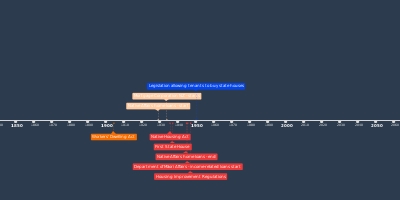1 avr. 1959 - Family Benefit: Capitalisation for housing - starts
Description:
The combination of legislation that allowed for the sale of state houses to tenants (Housing Act 1955) and the capitalisation of Family Benefit for housing, meant that many families were able to purchase a house from the state without any initial outlay of capital.The Family Benefit could be capitalised for the purpose of acquiring a new home, making essential additions to an existing home, or reducing or repaying a mortgage or other debt incurred before 1 January 1959 in the acquisition of a home. Capitalisation was not allowed on the first year of the life of a child or in respect of any period beyond the age of 16 years. The maximum capitalised value of benefit from the age of one year until the age of 16 was £473 16s. Application could be made to capitalise the benefit for any number of children in a family, but in no case could the capitalised amount exceed £1,000 or be less than £200. The purposes for which capitalisation may be approved were: to erect or purchase a new home; to repay, under certain conditions, mortgages or debts owing on the family home at 1 January 1959; or to meet the cost of alterations or additions to a home already owned in order to provide essential living accommodation for the family; to purchase land from the Crown with a dwelling thereon.
The Family Benefit could only be capitalised if the beneficiary (usually the mother) was the sole owner of the property or if the property is settled jointly in the names of husband and wife. In general, the advance was automatically cleared when the child whose benefit had been capitalised reached the age of 16 years, provided the property had continued to be used as a family home. If, however, circumstances arose whereby the benefit, if it had not been capitalised, would cease to be payable and the property ceases to be used as a family home (e.g. sold or let), reimbursement of the advance was required.
If the child died within one year of the date of capitalisation, the advance remains as a charge on the property until such time as reimbursement may be required, but if the child died more than one year after the date of capitalisation, reimbursement was not required. Applicants for capitalisation were required to satisfy two main considerations -(a) need of a home, (b) need of financial assistance to help to meet the cost of a home.
In conjunction with capitalisation of the Family Benefit, many homeowners obtained mortgages through the State Advances Corporation.
Source: https://www.msd.govt.nz/about-msd-and-our-work/about-msd/history/social-assistance-chronology-programme-history.html
Ajouté au bande de temps:
Date:
1 avr. 1959
Maintenaint
~ Il y a 66 ans
